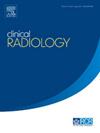Computed tomography morphomics and antifibrotic therapy in idiopathic pulmonary fibrosis
IF 2.1
3区 医学
Q2 RADIOLOGY, NUCLEAR MEDICINE & MEDICAL IMAGING
引用次数: 0
Abstract
AIM
Idiopathic pulmonary fibrosis (IPF) is a debilitating and fatal lung disease. Changes in body composition potentially correlate with outcomes in patients with IPF.
MATERIALS AND METHODS
Patients with IPF on antifibrotic treatment attending a single institution were identified and retrospectively evaluated (n=84). Three groups were formed based on antifibrotic treatment: pirfenidone group, nintedanib group and pirfenidone-nintedanib switch group. Morphomic analysis of muscle quantity (cross-sectional area in cm2) and quality (density in Hounsfield Units) on thoracic computed tomography (CT) was performed using a web-based morphomic segmentation tool. Bilateral erector spinae and pectoralis muscles were measured at pre-defined vertebral levels.
RESULTS
All three treatment groups showed a statistically significant decline in forced vital capacity (FVC), diffusion capacity of the lung for carbon monoxide (DLCO), pectoral muscle cross sectional area (PMA), and erector spinae muscle cross-sectional area (ESMA). Muscle density did not change significantly. Differences existed in analytic morphomics between treatment groups. Patients with a pretreatment body mass index (BMI) below 30 were found to have a significantly greater loss of PMA when treated with nintedanib instead of pirfenidone. FVC and DLCO did not differ between treatment groups.
CONCLUSION
There were no direct correlations between pulmonary function and morphomic parameters in our entire group of IPF patients. However, between different treatment groups, the rate of muscle bulk loss differed. This is an important consideration for clinicians when deciding on an antifibrotic agent of choice.
特发性肺纤维化的计算机断层形态组学和抗纤维化治疗。
目的:特发性肺纤维化(IPF)是一种使人衰弱和致命的肺部疾病。体成分的改变可能与IPF患者的预后相关。材料和方法:在单一机构接受抗纤维化治疗的IPF患者被确定并回顾性评估(n=84)。根据抗纤维化治疗分为三组:吡非尼酮组、尼达尼布组和吡非尼酮-尼达尼布切换组。使用基于网络的形态分割工具对胸部计算机断层扫描(CT)上的肌肉数量(以cm2为横截面积)和质量(以Hounsfield单位为密度)进行形态分析。在预定的椎体水平测量双侧竖脊肌和胸肌。结果:3个治疗组用力肺活量(FVC)、肺一氧化碳弥散量(DLCO)、胸肌横截面积(PMA)、竖脊肌横截面积(ESMA)均有统计学意义的下降。肌肉密度变化不显著。两组间分析型组学存在差异。预处理体重指数(BMI)低于30的患者在用尼达尼布代替吡非尼酮治疗时,PMA的损失明显更大。FVC和DLCO在治疗组间无显著差异。结论:本组IPF患者肺功能与形态学参数无直接相关性。然而,在不同的治疗组之间,肌肉体积损失的速度不同。这是临床医生在选择抗纤维化药物时的一个重要考虑因素。
本文章由计算机程序翻译,如有差异,请以英文原文为准。
求助全文
约1分钟内获得全文
求助全文
来源期刊

Clinical radiology
医学-核医学
CiteScore
4.70
自引率
3.80%
发文量
528
审稿时长
76 days
期刊介绍:
Clinical Radiology is published by Elsevier on behalf of The Royal College of Radiologists. Clinical Radiology is an International Journal bringing you original research, editorials and review articles on all aspects of diagnostic imaging, including:
• Computed tomography
• Magnetic resonance imaging
• Ultrasonography
• Digital radiology
• Interventional radiology
• Radiography
• Nuclear medicine
Papers on radiological protection, quality assurance, audit in radiology and matters relating to radiological training and education are also included. In addition, each issue contains correspondence, book reviews and notices of forthcoming events.
 求助内容:
求助内容: 应助结果提醒方式:
应助结果提醒方式:


